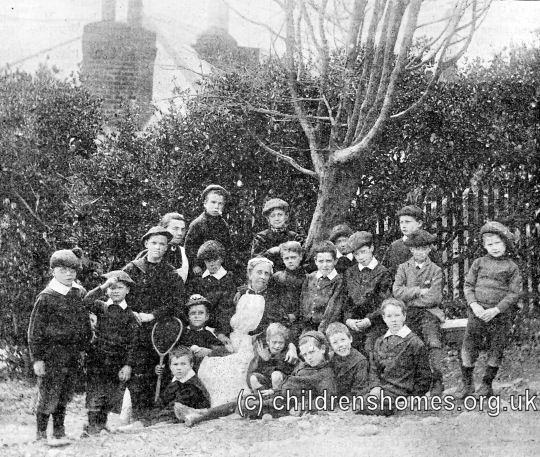St Michael's Home for Boys, Lyme Regis, Dorset
The St Michael's Home for Boys was opened by the Waifs and Strays Society in July, 1891, at Lyme Regis. It occupied a house that had been made available to the Society, rent-free, by the Rev. Edward Peek. The home was situated on Broad Street, with a path from its garden leading down to the beach. It could accommodate 20 boys from 5 to 10 years of age.

St Michael's Home for Boys, Lyme Regis, c.1897. © Peter Higginbotham
The boys rose early, with the eldest boy having to be at his work at 6.30am. In 1897, there were four who went out, returning to their breakfast at eight o'clock. The boys at home all sat down at half-past seven for bowls of porridge, after which beds are made, and then meet together in the small oratory for prayers. Then came school, and all returned home for dinner at 12.30, after which followed a game of football or a romp on the beach. Afternoon school was at two o'clock, and tea at five. After tea, there was usually dancing when the weather was cold until six o'clock, then prayers again in the oratory, after which the younger ones went to bed. The older ones then cleaned their boots and took turns in chopping wood and filling coal scuttles for the next day. The others who wee not on duty either played games or did wood carving or sang, with all in bed by 8.15 at the latest.
On Sundays, the boys wore sailor suits and on other days could be identified by the wearing of a scarlet cap.
The home closed in 1898 and the boys, together with the home's then matron, Miss Nosworthy, moved to new premises at Highweek, near Newton Abbot.
Records
Note: many repositories impose a closure period of up to 100 years for records identifying individuals. Before travelling a long distance, always check that the records you want to consult will be available.
- Index of the Society's first 30,000 children's case files ordered by surname.
- Index of the Society's first 30,000 children's case files ordered by date of birth.
- The Children's Society Records and Archive Centre is at Unit 25, Springfield House, 5 Tyssen Street, London E8 2LZ (email: archives@childrenssociety.org.uk). Files for children admitted to its homes after September 1926 were microfilmed in the 1980s and the originals destroyed. Some post-1926 files had already been damaged or destroyed during a flood. The Society's Post-Adoption and Care Service provides access to records, information, advice, birth record counselling, tracing and intermediary service for people who were in care or adopted through the Society.
- The Society has produced detailed catalogues of its records relating to disabled children, and of records relating to the Children's Union (a fundraising body mostly supported from the contributions of children).
Bibliography
- Bowder, Bill Children First: a photo-history of England's children in need (1980, Mowbray)
- Church of England Waifs and Strays' Society [Rudolfe, Edward de Montjoie] The First Forty Years: a chronicle of the Church of England Waifs and Strays' Society 1881-1920 (1922, Church of England Waifs and Strays' Society / S.P.C.K.)
- Higginbotham, Peter Children's Homes: A History of Institutional Care for Britain's Young (2017, Pen & Sword)
- Morris, Lester The Violets Are Mine: Tales of an Unwanted Orphan (2011, Xlibris Corporation) — memoir of a boy growing up in several of the Society's homes (Princes Risborough, Ashdon, Hunstanton, Leicester) in the 1940s and 50s.
- Rudolf, Mildred de Montjoie Everybody's Children: the story of the Church of England Children's Society 1921-1948 (1950, OUP)
- Stroud, John Thirteen Penny Stamps: the story of the Church of England Children's Society (Waifs and Strays) from 1881 to the 1970s (1971, Hodder and Stoughton)
Links
- Hidden Lives Revealed — the story of the children who were in the care of The Children's Society in late Victorian and early 20th Century Britain.
- The Children's Society
Except where indicated, this page () © Peter Higginbotham. Contents may not be reproduced without permission.


